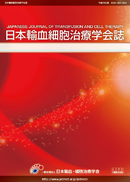Volume 67, Issue 3
Displaying 1-11 of 11 articles from this issue
- |<
- <
- 1
- >
- >|
Picture in Transfusion Medicine & Cell Therapy
-
2021Volume 67Issue 3 Pages 395-396
Published: June 25, 2021
Released on J-STAGE: July 16, 2021
Download PDF (209K)
Originals
-
2021Volume 67Issue 3 Pages 397-404
Published: June 25, 2021
Released on J-STAGE: July 16, 2021
Download PDF (523K) -
2021Volume 67Issue 3 Pages 405-413
Published: June 25, 2021
Released on J-STAGE: July 16, 2021
Download PDF (357K) -
2021Volume 67Issue 3 Pages 414-424
Published: June 25, 2021
Released on J-STAGE: July 16, 2021
Download PDF (832K) -
2021Volume 67Issue 3 Pages 425-431
Published: June 25, 2021
Released on J-STAGE: July 16, 2021
Download PDF (468K) -
2021Volume 67Issue 3 Pages 432-439
Published: June 25, 2021
Released on J-STAGE: July 16, 2021
Download PDF (369K) -
2021Volume 67Issue 3 Pages 440-448
Published: June 25, 2021
Released on J-STAGE: July 16, 2021
Download PDF (1022K)
Case Report
-
2021Volume 67Issue 3 Pages 449-454
Published: June 25, 2021
Released on J-STAGE: July 16, 2021
Download PDF (571K)
Activity Reports
-
2021Volume 67Issue 3 Pages 455-462
Published: June 25, 2021
Released on J-STAGE: July 16, 2021
Download PDF (942K) -
2021Volume 67Issue 3 Pages 463-469
Published: June 25, 2021
Released on J-STAGE: July 16, 2021
Download PDF (1098K)
Open Forum
-
IN-HOUSE SEPARATION IN A NATIONWIDE QUESTIONNAIRE SURVEY ON TRANSFUSION MEDICINE IN FISCAL YEAR 20182021Volume 67Issue 3 Pages 470-475
Published: June 25, 2021
Released on J-STAGE: July 16, 2021
Download PDF (805K)
- |<
- <
- 1
- >
- >|
